Greetings, fellow Skywatchers! The weekend has arrived at last and with it… more lunar challenge studies. Are you ready to dance with the pie-eyed piper as we seek out Piccolomini? You’ll find it to the southwest of the shallow ring of Fracastorius on Mare Nectaris’ southern shore. How about seeing double as we take on a few binary stars? It’s time to get out your binoculars and telescopes as we head to the Moon because… Here’s what’s up!
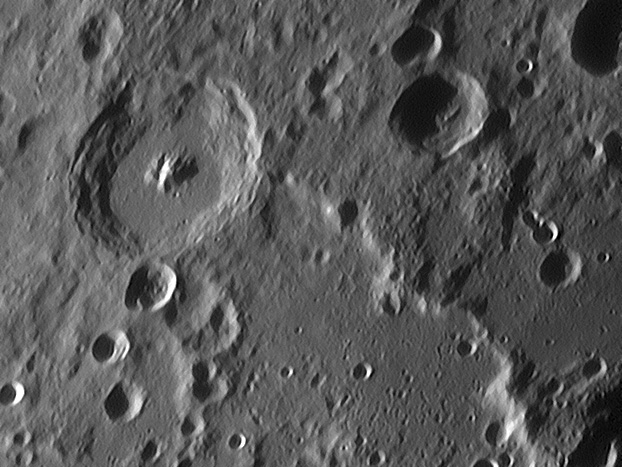 Friday, September 5, 2008 – Tonight let’s discover beauty on our own Moon as we have a look at one of the last lunar challenges of the year which occurs during the first few days of the Moon’s appearance – Piccolomini. You’ll find it to the southwest of the shallow ring of Fracastorius on Mare Nectaris’ southern shore. Piccolomini is a standout lunar feature – mainly because it is a fairly fresh impact crater. Its walls have not yet been destroyed by later impacts, and the interior is nicely terraced. Power up and look carefully at the northern interior wall where a rock slide may have rumbled toward the crater floor. While the floor itself is fairly featureless, the central peak is awesome. Rising a minimum of two kilometers above the floor, it is even higher than the White Mountains in New Hampshire!
Friday, September 5, 2008 – Tonight let’s discover beauty on our own Moon as we have a look at one of the last lunar challenges of the year which occurs during the first few days of the Moon’s appearance – Piccolomini. You’ll find it to the southwest of the shallow ring of Fracastorius on Mare Nectaris’ southern shore. Piccolomini is a standout lunar feature – mainly because it is a fairly fresh impact crater. Its walls have not yet been destroyed by later impacts, and the interior is nicely terraced. Power up and look carefully at the northern interior wall where a rock slide may have rumbled toward the crater floor. While the floor itself is fairly featureless, the central peak is awesome. Rising a minimum of two kilometers above the floor, it is even higher than the White Mountains in New Hampshire!
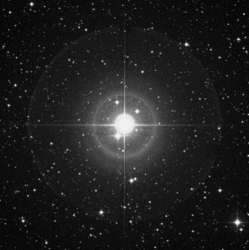 When you’ve caught up on your studies, let’s have a look at Beta and Gamma Lyrae, the lower two stars in the “Harp.” Beta is actually a quickly changing variable which drops to less than half the brightness of Gamma in around 12 days. For a few days the pair will seem of almost equal brightness; then you will notice the star closest to Vega begins to fade away. Beta is one of the most unusual spectroscopic stars in the sky, and it is possible that its eclipsing binary companion may be a prototypical “collapsar” (Yep – a black hole!) rather than an actual luminous body.
When you’ve caught up on your studies, let’s have a look at Beta and Gamma Lyrae, the lower two stars in the “Harp.” Beta is actually a quickly changing variable which drops to less than half the brightness of Gamma in around 12 days. For a few days the pair will seem of almost equal brightness; then you will notice the star closest to Vega begins to fade away. Beta is one of the most unusual spectroscopic stars in the sky, and it is possible that its eclipsing binary companion may be a prototypical “collapsar” (Yep – a black hole!) rather than an actual luminous body.
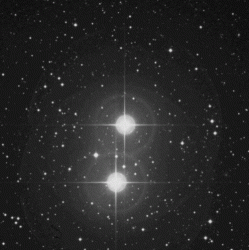 Now use the telescope for a pair of stars which are very close – Epsilon Lyrae (RA 18 44 20 Dec +39 40 12). Known to most of us as the “Double Double,” look about a fingerwidth northeast of Vega. Even the slightest optical aid will reveal this tiny star as a pair, but the real treat is with a telescope – because each component is a double star! Both sets of stars appear as primarily white, and each pair is very close in magnitude. What is the lowest power that you can use to split them?
Now use the telescope for a pair of stars which are very close – Epsilon Lyrae (RA 18 44 20 Dec +39 40 12). Known to most of us as the “Double Double,” look about a fingerwidth northeast of Vega. Even the slightest optical aid will reveal this tiny star as a pair, but the real treat is with a telescope – because each component is a double star! Both sets of stars appear as primarily white, and each pair is very close in magnitude. What is the lowest power that you can use to split them?
 Saturday, September 6, 2008 – Today celebrates the founding of the Astronomical and Astrophysical Society of America. Started in 1899, it is now known as the American Astronomical Society. Also on this date, in 2006, the milestone 1500th episode of Jack Horkheimer’s Star Gazer series aired. The long-running short program on public television has led thousands of people, young and old, to “keep on looking up!” For a lifetime of achievement in public outreach, we salute you, Mr. Horkheimer!
Saturday, September 6, 2008 – Today celebrates the founding of the Astronomical and Astrophysical Society of America. Started in 1899, it is now known as the American Astronomical Society. Also on this date, in 2006, the milestone 1500th episode of Jack Horkheimer’s Star Gazer series aired. The long-running short program on public television has led thousands of people, young and old, to “keep on looking up!” For a lifetime of achievement in public outreach, we salute you, Mr. Horkheimer!
Tonight when you have had a look at the Serpentine Ridge, drop south along the terminator and see if you can identify the very old crater Abulfeda, west of Theophilus.
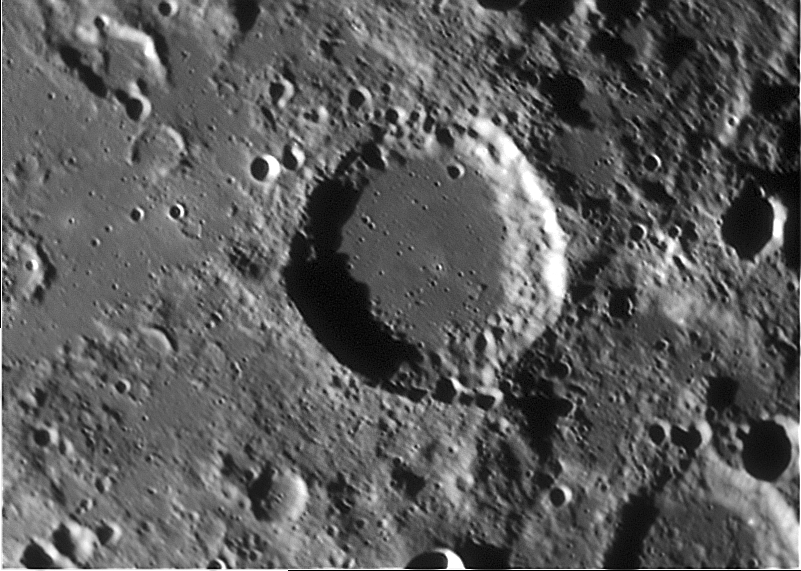 This charming crater was named for Prince Ismail Abu’l Feda, who was a Syrian geographer and astronomer born in the late thirteenth century. Spanning 62 kilometers, its rocky walls show what once was a great depth, but the crater is now filled-in by lava, and drops to a mere 3110 meters below the surface. While it doesn’t appear very large to the telescope, that’s quite big enough to entirely hide Mt. Siple – one of the highest peaks in Antarctica! If conditions are steady, power up and take a look at Albulfeda’s smooth-appearing floor. Can you see many smaller strikes? If the lighting is correct, you might even spot one far younger than the others!
This charming crater was named for Prince Ismail Abu’l Feda, who was a Syrian geographer and astronomer born in the late thirteenth century. Spanning 62 kilometers, its rocky walls show what once was a great depth, but the crater is now filled-in by lava, and drops to a mere 3110 meters below the surface. While it doesn’t appear very large to the telescope, that’s quite big enough to entirely hide Mt. Siple – one of the highest peaks in Antarctica! If conditions are steady, power up and take a look at Albulfeda’s smooth-appearing floor. Can you see many smaller strikes? If the lighting is correct, you might even spot one far younger than the others!
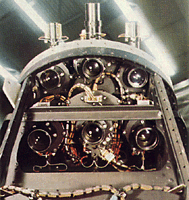 Sunday, September 7 – For binoculars and telescopes, tonight’s Moon will provide a piece of scenic history as we take an in-depth look at crater Albategnius. This huge, hexagonal, mountain-walled plain will appear near the terminator about one-third the way up from the south limb. This 136 kilometer wide crater is approximately 4390 meters deep, and its west wall will cast a black shadow on the dark floor. Albategnius is a very ancient formation, which partially filled with lava at one point in its development. It is home to several wall craters like Klein (which will appear telescopically on its southwest wall). Albategnius holds more than just the distinction of being a prominent crater – it holds a place in history. On May 9, 1962 Louis Smullin and Giorgio Fiocco of the Massachusetts Institute of technology aimed a red laser toward the lunar surface and Albategnius became the first lunar object to be illuminated by a laser and then detected from Earth!
Sunday, September 7 – For binoculars and telescopes, tonight’s Moon will provide a piece of scenic history as we take an in-depth look at crater Albategnius. This huge, hexagonal, mountain-walled plain will appear near the terminator about one-third the way up from the south limb. This 136 kilometer wide crater is approximately 4390 meters deep, and its west wall will cast a black shadow on the dark floor. Albategnius is a very ancient formation, which partially filled with lava at one point in its development. It is home to several wall craters like Klein (which will appear telescopically on its southwest wall). Albategnius holds more than just the distinction of being a prominent crater – it holds a place in history. On May 9, 1962 Louis Smullin and Giorgio Fiocco of the Massachusetts Institute of technology aimed a red laser toward the lunar surface and Albategnius became the first lunar object to be illuminated by a laser and then detected from Earth!
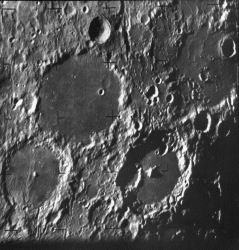 On March 24, 1965 Ranger 9 took this “snapshot” of Albategnius (in the lower right of the lunar image) from an altitude of approximately 2500 kilometers. Companion craters in the image are Ptolemaeus and Alphonsus, which will be revealed for us tomorrow night. Ranger 9 was designed by NASA for one purpose – to achieve a lunar impact trajectory and send back high-resolution photographs and high-quality video images of the lunar surface. It carried no other scientific experiments, and its only destiny was to take pictures right up to the moment of final impact. It is interesting to note that Ranger 9 slammed into Alphonsus approximately 18.5 minutes after the lunar photo was taken. They called that…a “hard landing.”
On March 24, 1965 Ranger 9 took this “snapshot” of Albategnius (in the lower right of the lunar image) from an altitude of approximately 2500 kilometers. Companion craters in the image are Ptolemaeus and Alphonsus, which will be revealed for us tomorrow night. Ranger 9 was designed by NASA for one purpose – to achieve a lunar impact trajectory and send back high-resolution photographs and high-quality video images of the lunar surface. It carried no other scientific experiments, and its only destiny was to take pictures right up to the moment of final impact. It is interesting to note that Ranger 9 slammed into Alphonsus approximately 18.5 minutes after the lunar photo was taken. They called that…a “hard landing.”
As the week progresses, watch as the Moon draws closer for a near event with Jupiter by Wednesday. While the pair will still be separated by around two degrees it will still be an awesome sight that doesn’t require a telescope to enjoy!
Wishing you clear skies…
This week’s awesome images are Crater Piccolomini – Credit: Oliver Pettenpaul (LPOD), Beta Lyrae – Credit: Palomar Observatory, courtesy of Caltech, Beta Lyrae – Credit: Palomar Observatory, courtesy of Caltech, Crater Abulfeda – Credit: Wes Higgins, Ranger 9 Image of Lunar Surface and Image of Lunar Surface – Credit: NASA. We thank you!!

